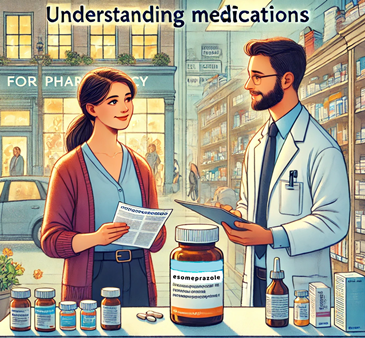How to Calculate the Number of Insulin Vials Needed for a Patient
How to Calculate the Number of Insulin Vials Needed for a Patient
Accurately calculating the number of insulin vials needed for a patient is essential for ensuring they have enough medication to manage their diabetes without interruption. Whether you're a pharmacy technician or a healthcare provider, understanding the calculation process will help you confidently assist patients with their insulin therapy.
In this post, we will break down the steps to determine the exact number of vials required based on the patient’s total
The Meaning Behind the ‘Es’ in Esomeprazole vs. Omeprazole
What is the Meaning Behind the 'Es' in Esomeprazole vs. Omeprazole?
Imagine looking at your reflection in a mirror, holding up your hands. Your left and right hands look alike, but they aren't exactly the same—they're mirror images of each other. You can’t place one hand over the other and have them line up perfectly; they’re different in their orientation. In the world of chemistry and medicine, this idea of
Medications for Seasonal Allergies
Medications for Seasonal Allergies: A Comprehensive Guide for Pharmacists and Pharmacy Technicians
Seasonal allergies, also known as hay fever or allergic rhinitis, are a common condition that affects millions of people worldwide. As pharmacists and pharmacy technicians, understanding the medications used to manage these allergies is essential to provide optimal patient care. This blog post will cover the mechanism of action, side effects, dosing, and commonly prescribed medications for seasonal allergies.
Understanding Seasonal Allergies
Seasonal allergies occur when the immune system overreacts to allergens
A Restful Night: Finding the Right Medication for Insomnia
A Restful Night: Finding the Right Medication for Insomnia
Samantha had been struggling with insomnia for months. Every night, she would lie in bed, staring at the ceiling, unable to drift off. Her days were filled with exhaustion, and her performance at work was starting to suffer. Desperate for relief, she decided to visit her local pharmacy.
"Hi, I'm Samantha. I've been having terrible insomnia for months now, and I really need something to help me sleep," she explained to Michael, the pharmacist.
Michael
A Foot to Stand On: A Journey to Finding the Right Medication for Athlete’s Foot
A Foot to Stand On: A Journey to Finding the Right Medication for Athlete's Foot
Jake had been battling a persistent itch between his toes for weeks. At first, he thought it was just dry skin, but the red, scaly patches and constant burning sensation told a different story. As a gym enthusiast, he knew the culprit: athlete's foot. Frustrated and desperate for relief, Jake decided to take matters into his own hands.
He started with an over-the-counter cream he found at the
Understanding Medications for Heartburn
A Journey to Heartburn Relief
Emma had been struggling with heartburn for months. The burning sensation in her chest was relentless, especially after meals or when she tried to sleep. She was desperate for relief and had tried various over-the-counter medications, but nothing seemed to work for long.
One evening, after another painful bout of heartburn, Emma decided to visit her local pharmacy. She walked in, greeted by the familiar scent of antiseptics and the sight of neatly stacked shelves filled
Narcotic Pain Relievers
What is a narcotic?
A narcotic is a pain-reducing chemical derived from opium (or synthetically produced) with the side effects of euphoria, stupor, and insensibility.
- Opiate – is a naturally occurring narcotic alkaloid found in the opium poppy plant, such as
- Morphine
- Codeine
- Opioid – any fully or semi-synthetic narcotic (does not come directly from the poppy plant) that has opiate-like activity (made to mimic the effects of an opiate), such as
- Hydrocodone
- Oxycodone
The terms opiate and opioid are often used interchangeably, although there is a distinct difference. But under
Medications for Anxiety and Panic Disorders
The major class of medication used to treat anxiety and panic disorders is called benzodiazepine sedative hypnotic anxiolytics. Benzodiazepines are medications that work on the central nervous system (by enhancing the inhibitory effects of GABA) and are used as sedatives (calming effect), hypnotics (sleep aid), and anxiolytics (relieves anxiety).
Benzodiazepines are not for everyday stress and anxiety; they are prescribed for chronic and/or debilitating anxiety, panic disorders, and post-traumatic stress. Because the risk of dependence is high, many









